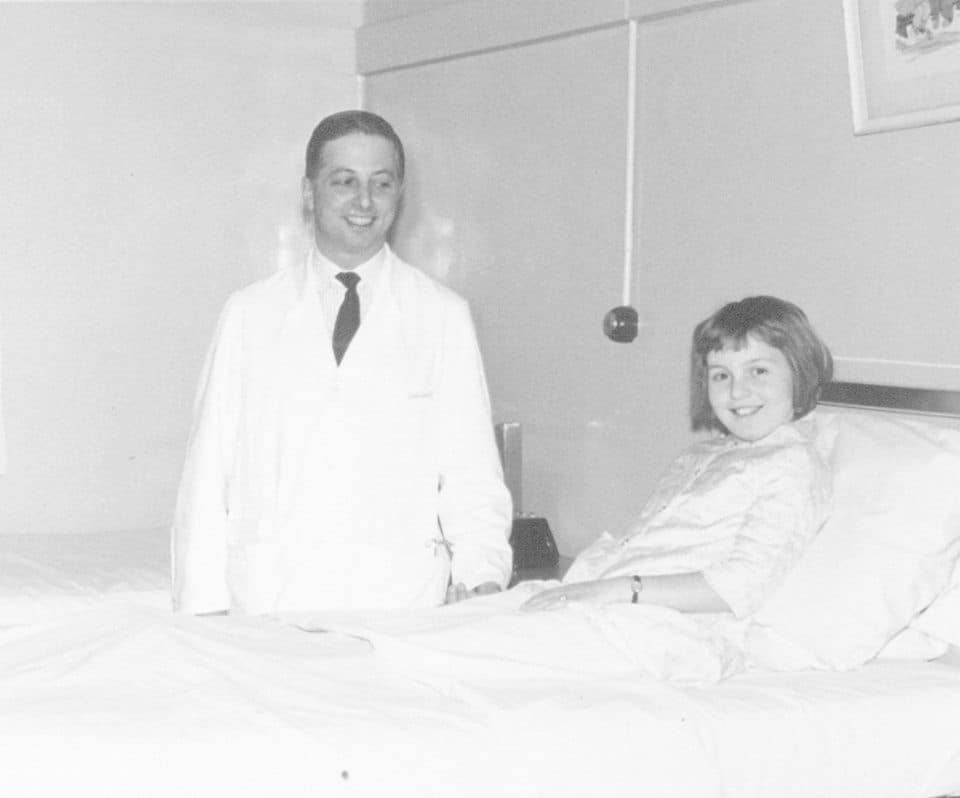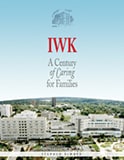Dr. Richard Goldbloom, an iconic figure in pediatric care in Canada and the first Chief of Pediatrics at Halifax’s Izaak Walton Killam Hospital for Children, died on November 18, 2021, at the age of 96. He was a major figure in the development of the IWK and in the book I wrote about the hospital’s history, IWK: A Century of Caring for Families. Here’s a brief excerpt from the book that describes how he was lured to Halifax in the late 1960s.

Richard Goldbloom was happy where he was, thank you very much. He was forty-three-years old, a well-established Montreal pediatrician with a successful private practice who’d recently accepted a fulltime appointment to the staff of the Montreal Children’s Hospital and who enjoyed the very real prospect of becoming that hospital’s next chief of staff.
His roots—in both medicine and Montreal—ran deep.
His father Alton was Montreal’s first trained pediatrician[1] (and a former chief of staff at the Montreal Children’s Hospital). His mother’s brother was a doctor. So was his own brother Victor.[2] And Richard himself had wanted to be a doctor for so long he’d begun signing his name “Richard Goldbloom, MD” when he only was six years old. [3]
He was a Montrealer too. Born and bred. Bilingual and bicultural. Unlike many of his Anglophone contemporaries in the mid-sixties, Goldbloom wasn’t angling for a way out of a province many believed was becoming too French, too separatist, too dangerous. “I liked living in Montreal,” he says simply.
So why was he considering leaving? And, perhaps even more inconceivable, why was he considering moving to Halifax? He was not without other, more obviously alluring prospects. He had already been considered, for example, as a candidate for a job as the head of the pediatrics department in Vancouver.
So why Halifax? In part, it was simply that he’d been asked—and more than just nicely. He was sitting in his office at the hospital one morning in 1967 when the phone rang. It was Chester Stewart, the Dean of Medicine at Dalhousie University. Goldbloom had never heard of him. “I’m staying at the Ritz,” Stewart began. “I came to Montreal specifically to talk with you about an opportunity in Nova Scotia, and I’m not leaving until we do. So when do you have some time?”[4]
Today, Goldbloom laughs. “My ego has never been massaged to that degree before or since.”
But being asked wasn’t the only reason to take the job. As Stewart laid out the tablesetting of the positions he was dangling—Professor of Pediatrics at Dalhousie and Chief of Pedicatrics at the new Izaak Walton Killam Hospital for Children—it quickly became clear this had the potential to be a once-in-a-lifetime, career-changing opportunity.
The new Halifax hospital would be the first children’s hospital to be built in Canada in more than twenty years. Most children’s medical facilities in the country still focused almost exclusively on “doing” medicine rather than on teaching and research. This would be an opportunity to create something new and very different.
“Nova Scotia was virgin territory,” says Goldbloom, “a great opportunity.”
What made that great opportunity even more appealing was that the new hospital would not be just any hospital. Its construction was being funded by Killam money. “Money,” Stewart had explained, “was no object.”
Richard Goldbloom didn’t know the Killams. But he certainly knew of them. Izaak Killam had once stolen away his father’s chauffeur! In the 1930s and forties in downtown Montreal, traffic was so congested and parking space at such a premium that many doctors—including Richard’s father—hired chauffeurs to drive them to and from their house calls. “One day my father’s chauffeur quit and went to work for the Killams for a lot more money.”
Goldbloom also knew that Ike Killam had served on the board of the Montreal Children’s Hospital where he’d steadfastly maintained his taciturn reputation for saying absolutely nothing during meetings. Not that that was so unusual. “In those days,” Goldbloom remembers, “most hospital boards were almost entirely made up of wealthy men who, at the end of the year, would get together and whisper very genteelly to one another and then take out their cheque books and each write a cheque to help deal with the hospital’s annual operating deficit. They had almost nothing to do with the running of the hospital.”
Which suited Goldbloom just fine too.
There was also another, personal factor that made the idea of moving to Halifax attractive. Richard’s wife Ruth had grown up in New Waterford, Cape Breton. They’d met in Montreal in the 1940s when Ruth was supposedly passing through Montreal on her way to study physical education at Queen’s University. A friend had met her at the train station and convinced her she should stay and attend university at McGill instead. Soon after, says Goldbloom, “we met and the rest, as they say, is history.” Goldbloom had visited Cape Breton himself and he’d also spent two summers of his medical training working at a miners’ hospital there. “It was one of the best experiences of my medical education.”
So he was intrigued enough to at least come to Halifax to talk to the selection committee, which did its best to wine, dine and woo him. At one point, the 10-member committee and the target of their wooing ended up at a lunch in the upstairs dining room of the Royal Nova Scotia Yacht Squadron, which commanded an excellent view of Halifax Harbour.
“Now Doc,” committee member Stewart Wenning said as they were finishing their meal, “tell me, is there anything about this job that you’re not happy about?”
“Well, yes, there is one thing,” Goldbloom began tentatively.
“Well, what is it , Doc?”
“Well, the name bothers me; the name Izaak Killam Hospital for Children. I know why you’re calling it that and I understand, but—whether you like it or not—people are going to call it the ‘I Kill’em Hospital.’ It just doesn’t sound good.”
Wenning, a veteran anesthesiologist who’d been a member of the planning committee for the new hospital from the time when it was expected to be just a modest replacement institution, didn’t miss a beat. He looked Goldbloom straight in the eye. “Doc,” he said flatly, “eight million bucks you ain’t worth!”
The name stayed, and so did Richard Goldbloom.
From IWK: A Century of Caring for Families by Stephen Kimber (Nimbus, 2009)
For more on Dr. Goldbloom’s life
[1] His role model had been Dr. William Molson of the famous Montreal brewing family who cared for many of the Jewish immigrant families in Montreal at the time. “My grandmother would say to my father, ‘I want you to grow up and be like Dr. Molson.’”
[2] At one point early in his career, Richard and his brother worked with their father in his Crescent Street home-office. “People would phone up and say in French, ‘Allo, Dr. Goldbloom?’ My father would say, ‘Oui,’ and the next question would usually be ‘Est que c’est le pers ou le fils?’ Is it the father or the son? And my father would say, ‘Non, c’est le Saint-Esprit.’ It’s the Holy Spirit. He loved that joke.”
[3] To continue the tradition, two of Goldbloom’s children, Alan and David, became doctors (Alan a pediatrician) and his grand-daughter Ellen is also a pediatrician.
[4] Though he’d never even heard of Stewart before that call, Goldbloom says he learned “the greatest lesson” that day in how-to woo job prospects, “techniques I’ve since used myself on many occasions since then.” The lesson: “The value the recruiter puts on the job will be the determinant of the value the prospective candidate puts on the job.”




 STEPHEN KIMBER, a Professor of Journalism at the University of King's College in Halifax and co-founder of its MFA in Creative Nonfiction Program, is an award-winning writer, editor and broadcaster. He is the author of two novels and eight non-fiction books. Buy his books
STEPHEN KIMBER, a Professor of Journalism at the University of King's College in Halifax and co-founder of its MFA in Creative Nonfiction Program, is an award-winning writer, editor and broadcaster. He is the author of two novels and eight non-fiction books. Buy his books